Diachronous Redistribution of Hf and Nd Isotopes at the Crystal Scale—Consequences for the Isotopic Evolution of a Poly-Metamorphic Crustal Terrane
Abstract
:1. Introduction
2. The Saglek Block, an Archean Poly-Metamorphic Terrane
3. Methods
3.1. Sampling Strategy
3.2. Apatite U–Pb/Sm–Nd LASS Analyses
3.3. Whole-Rock Sm–Nd Isotope Analyses
3.4. Uncertainty in Isotopic Ratio and Values Derived from It
4. Results
4.1. Apatite U–Pb/Sm–Nd Isotopes LASS Analyses
4.1.1. Amphibolite Facies Grey Gneiss LA12-08
4.1.2. Metatexite LA9-01
4.2. Whole-Rock Sm–Nd Isotopes Analyses
5. Discussions
5.1. Significance of Apatite U–Pb/Sm–Nd LASS Analyses
5.1.1. Effect of Metamorphism on U–Pb and Sm–Nd Isotope Signatures in Apatite and Zircon
5.1.2. Timing and Conditions of Apatite Crystallization in the Saglek Block
5.1.3. Correlation with Regional Events
5.2. Diachronous Redistribution of Hf and Nd Isotopes in the Saglek Block
5.3. The Neoarchean Metamorphic History of the Saglek Block
- Igneous activity at ca. 3.87 Ga was sourced from a mantle domain that had experienced only subtle prior fractionation of parent–daughter isotopes, which had incorporated hydrothermally altered material before partial melting. This is based on previously published zircon U–Pb/Hf/O-isotopes analyses [5,47];
- High-grade metamorphism at ca. 3.5 Ga. This event caused the partial re-opening of older zircon domains (major Pb-loss) making it difficult to identify the true emplacement age of older igneous rocks. New zircon growth was also recognized during this event. Zircon Hf-isotopes largely indicate intra-crustal reworking, whereas zircon O–isotopes revealed the involvement of mature supracrustal precursors (mafic volcanics ± clastic/chemical sediments);
- An early-Neoarchean regional high-grade metamorphism at ca. 2.7 Ga, that also caused the partial re-opening of zircon and significant Pb-loss. New zircon growth has also been identified during this event. Several populations of REE-rich phases also yielded a ca. 2.7 Ga-old U–Pb apparent age;
- Late-Neoarchean/early-Paleoproterozoic metamorphism at ca. 2.5–2.4 Ga (+2.2 Ga?). Massive (re)-recrystallization of REE-rich mineral phases at the regional scale, especially apatite and titanite. Sm–Nd isotopes indicated intra-crustal reworking. An accurate dating of the termination of this event cannot yet be constrained, due to the readiness of REE-rich phases to react under low-grade metamorphism in fluid-present environments.
6. Conclusions
Supplementary Materials
Author Contributions
Funding
Institutional Review Board Statement
Informed Consent Statement
Data Availability Statement
Acknowledgments
Conflicts of Interest
References
- Hiess, J.; Bennett, V.C.; Nutman, A.P.; Williams, I.S. In situ U–Pb, O and Hf isotopic compositions of zircon and olivine from Eoarchaean rocks, West Greenland: New insights to making old crust. Geochim. Cosmochim. Acta 2009, 73, 4489–4516. [Google Scholar] [CrossRef] [Green Version]
- Hiess, J.; Bennett, V.C.; Nutman, A.P.; Williams, I.S. Archaean fluid-assisted crustal cannibalism recorded by low δ18O and negative εHf(T) isotopic signatures of West Greenland granite zircon. Contrib. Mineral. Petrol. 2011, 161, 1027–1050. [Google Scholar] [CrossRef] [Green Version]
- Hiess, J.; Bennett, V.C. Chondritic Lu/Hf in the early crust–mantle system as recorded by zircon populations from the oldest Eoarchean rocks of Yilgarn Craton, West Australia and Enderby Land, Antarctica. Chem. Geol. 2016, 427, 125–143. [Google Scholar] [CrossRef]
- Petersson, A.; Kemp, A.I.; Hickman, A.H.; Whitehouse, M.J.; Martin, L.; Gray, C.M. A new 3.59 Ga magmatic suite and a chondritic source to the east Pilbara Craton. Chem. Geol. 2019, 511, 51–70. [Google Scholar] [CrossRef]
- Vezinet, A.; Pearson, D.G.; Thomassot, E.; Stern, R.A.; Sarkar, C.; Luo, Y.; Fisher, C.M. Hydrothermally-altered mafic crust as source for early Earth TTG: Pb/Hf/O isotope and trace element evidence in zircon derived from TTG of the Eoarchean Saglek Block, N. Labrador. EPSL 2018, 503, 95–107. [Google Scholar] [CrossRef]
- Dhuime, B.; Hawkesworth, C.J.; Delavault, H.; Cawood, P.A. Rates of generation and destruction of the continental crust: Implications for continental growth. Philos. Trans. R. Soc. A Math. Phys. Eng. Sci. 2018, 376, 20170403. [Google Scholar] [CrossRef] [Green Version]
- Korenaga, J. Estimating the formation age distribution of continental crust by unmixing zircon ages. EPSL 2018, 482, 388–395. [Google Scholar] [CrossRef]
- Korenaga, J. Hadean geodynamics and the nature of early continental crust. Precambr. Res. 2021, 359, 106178. [Google Scholar] [CrossRef]
- Engi, M. Petrochronology based on REE-minerals: Monazite, allanite, xenotime, apatite. Rev. Mineral. Geochem. 2017, 83, 365–418. [Google Scholar] [CrossRef]
- Bruand, E.; Fowler, M.; Storey, C.; Laurent, O.; Antoine, C.; Guitreau, M.; Heilimo, E.; Nebel, O. Accessory mineral constraints on crustal evolution: Elemental fingerprints for magma discrimination. Geochem. Perspect. Letters 2020, 13, 7–12. [Google Scholar] [CrossRef] [Green Version]
- Aleinikoff, J.N.; Wintsch, R.P.; Fanning, C.M.; Dorais, M.J. U–Pb geochronology of zircon and polygenetic titanite from the Glastonbury Complex, Connecticut, USA: An integrated SEM, EMPA, TIMS, and SHRIMP study. Chem. Geol. 2002, 188, 125–147. [Google Scholar] [CrossRef]
- Foster, G.L.; Vance, D. In situ Nd isotopic analysis of geological materials by laser ablation MC-ICP-MS. J. Anal. At. Spectrom. 2006, 21, 288–296. [Google Scholar] [CrossRef]
- Storey, C.D.; Jeffries, T.E.; Smith, M. Common lead-corrected laser ablation ICP–MS U–Pb systematics and geochronology of titanite. Chem. Geol. 2006, 227, 37–52. [Google Scholar] [CrossRef]
- McFarlane, C.R.M.; McCulloch, M.T. Coupling of in-situ Sm–Nd systematics and U–Pb dating of monazite and allanite with applications to crustal evolution studies. Chem. Geol. 2007, 245, 45–60. [Google Scholar] [CrossRef]
- Frost, B.R.; Chamberlain, K.R.; Schumacher, J.C. Sphene (titanite): Phase relations and role as a geochronometer. Chem. Geol. 2001, 172, 131–148. [Google Scholar] [CrossRef]
- Kohn, M.J. Titanite petrochronology. Rev. Mineral. Geochem. 2017, 83, 419–441. [Google Scholar] [CrossRef]
- Spear, F.S.; Pyle, J.M. Apatite, monazite, and xenotime in metamorphic rocks. Rev. Mineral. Geochem. 2002, 48, 293–335. [Google Scholar] [CrossRef]
- Henrichs, I.A.; O’Sullivan, G.; Chew, D.M.; Mark, C.; Babechuk, M.G.; McKenna, C.; Emo, R. The trace element and U-Pb systematics of metamorphic apatite. Chem. Geol. 2018, 483, 218–238. [Google Scholar] [CrossRef]
- Janots, E.; Austrheim, H.; Spandler, C.; Hammerli, J.; Trepmann, C.A.; Berndt, J.; Magnin, V.; Kemp, A.I. Rare earth elements and Sm-Nd isotope redistribution in apatite and accessory minerals in retrogressed lower crust material (Bergen Arcs, Norway). Chem. Geol. 2018, 484, 120–135. [Google Scholar] [CrossRef]
- Taylor, R.J.; Kirkland, C.L.; Clark, C. Accessories after the facts: Constraining the timing, duration and conditions of high-temperature metamorphic processes. Lithos 2016, 264, 239–257. [Google Scholar] [CrossRef]
- Bridgwater, D.; Rosing, M.; Schiøtte, L.; Austrheim, H. The effect of fluid-controlled element mobility during metamorphism on whole rock isotope systems, some theoretical aspects and possible examples. In Fluid Movements—Element Transport and the Composition of the Deep Crust; Springer: Dordrecht, The Netherlands, 1989; pp. 277–298. [Google Scholar]
- Schiøtte, L. On the possible role of fluid transport in the distribution of U and Pb in an Archaean gneiss complex. In Fluid Movements—Element Transport and the Composition of the Deep Crust; Springer: Dordrecht, The Netherlands, 1989; pp. 299–317. [Google Scholar]
- Moorbath, S.; Whitehouse, M.; Kamber, B. Extreme Nd-isotope heterogeneity in the early Archaean—fact or fiction? Case histories from northern Canada and West Greenland. Chem. Geol. 1997, 135, 213–231. [Google Scholar] [CrossRef]
- Vezinet, A.; Pearson, D.G.; Thomassot, E. Effects of contamination on whole-rock isochrons in ancient rocks: A numerical modelling approach. Lithos 2021, 386–387, 106040. [Google Scholar] [CrossRef]
- Hammerli, J.; Kemp, A.; Spandler, C. Neodymium isotope equilibration during crustal metamorphism revealed by in situ microanalysis of REE-rich accessory minerals. EPSL 2014, 392, 133–142. [Google Scholar] [CrossRef]
- Gregory, C.J.; McFarlane, C.R.; Hermann, J.; Rubatto, D. Tracing the evolution of calc-alkaline magmas: In-situ Sm–Nd isotope studies of accessory minerals in the Bergell Igneous Complex, Italy. Chem. Geol. 2009, 260, 73–86. [Google Scholar] [CrossRef] [Green Version]
- Hammerli, J.; Kemp, A.I.; Whitehouse, M.J. In situ trace element and Sm-Nd isotope analysis of accessory minerals in an Eoarchean tonalitic gneiss from Greenland: Implications for Hf and Nd isotope decoupling in Earth’s ancient rocks. Chem. Geol. 2019, 524, 394–405. [Google Scholar] [CrossRef]
- Fisher, C.M.; Bauer, A.M.; Luo, Y.; Sarkar, C.; Hanchar, J.M.; Vervoort, J.D.; Tapster, S.R.; Horstwood, M.; Pearson, D.G. Laser ablation split-stream analysis of the Sm-Nd and U-Pb isotope compositions of monazite, titanite, and apatite–Improvements, potential reference materials, and application to the Archean Saglek Block gneisses. Chem. Geol. 2020, 539, 119493. [Google Scholar] [CrossRef]
- Zhou, G.; Fisher, C.M.; Luo, Y.; Pearson, D.G.; Li, L.; He, Y.; Wu, Y. A clearer view of crustal evolution: U-Pb, Sm-Nd, and Lu-Hf isotope systematics in five detrital minerals unravel the tectonothermal history of northern China. Geol. Soc. Am. Bull. 2020. [Google Scholar] [CrossRef]
- Vezinet, A.; Thomassot, E.; Pearson, D.G.; Luo, Y.; Sarkar, C.; Ternois, S. One mineral, two conflicting isotopic clocks: The effect of metamorphic mixing at the crystal scale. G-cubed manuscript in preparation.
- Hurst, R.W.; Bridgwater, D.; Collerson, K.D.; Wetherill, G.W. 3600-My Rb-Sr ages from very early Archaean gneisses from Saglek Bay, Labrador. EPSL 1975, 27, 393–403. [Google Scholar] [CrossRef]
- Bridgwater, D.; Collerson, K.D. The major petrological and geochemical characters of the 3,600 My Uivak gneisses from Labrador. Contrib. Mineral. Petrol. 1976, 54, 43–59. [Google Scholar] [CrossRef]
- Collerson, K.D.; Bridgwater, D. Metamorphic development of early Archaean tonalitic and trondhjemitic gneisses: Saglek area, Labrador. In Trondhjemites, Dacites and Related Rocks; Barker, F., Ed.; Developments in Petrology; Elsevier: Amsterdam, The Netherlands, 1979; Volume 6, pp. 205–274. [Google Scholar]
- Wendt, J.I.; Collerson, K.D. Early Archaean U/Pb fractionation and timing of late Archaean high-grade metamorphism in the Saglek–Hebron segment of the North Atlantic Craton. Precambr. Res. 1999, 93, 281–297. [Google Scholar] [CrossRef]
- Schiøtte, L.; Bridgwater, D.; Collerson, K.D.; Nutman, A.P.; Ryan, B. Chemical and isotopic effects of late Archaean high-grade metamorphism and granite injection on early Archaean gneisses, Saglek-Hebron, northern Labrador. Geol. Soc. Lond. Spec. Publ. 1986, 24, 261–273. [Google Scholar] [CrossRef]
- Barton, J.M.J. Rb-Sr isotopic characteristics and chemistry of the 3.6-by Hebron gneiss, Labrador. EPSL 1975, 27, 427–435. [Google Scholar] [CrossRef]
- Collerson, K.D. The Archean gneiss complex of northern Labrador. 2. Mineral ages, secondary isochrons, and diffusion of strontium during polymetamorphism of the Uivak gneisses. Can. J. Earth Sci. 1983, 20, 707–718. [Google Scholar] [CrossRef]
- Sałacińska, A.; Kusiak, M.A.; Whitehouse, M.J.; Dunkley, D.J.; Wilde, S.A.; Kielman, R. Complexity of the early Archean Uivak Gneiss: Insights from Tigigakyuk Inlet, Saglek Block, Labrador, Canada and possible correlations with south West Greenland. Precambr. Res. 2018, 315, 103–119. [Google Scholar] [CrossRef] [Green Version]
- Kusiak, M.A.; Dunkley, D.J.; Whitehouse, M.J.; Wilde, S.A.; Sałacińska, A.; Konečný, P.; Szopa, K.; Gawęda, A.; Chew, D. Peak to post-peak thermal history of the Saglek Block of Labrador: A multiphase and multi-instrumental approach to geochronology. Chem. Geol. 2018, 484, 210–223. [Google Scholar] [CrossRef] [Green Version]
- Dunkley, D.J.; Kusiak, M.A.; Wilde, S.A.; Whitehouse, M.J.; Sałacińska, A.; Kielman, R.; Konečný, P. Two Neoarchean tectonothermal events on the western edge of the North Atlantic Craton, as revealed by SIMS dating of the Saglek Block, Nain Province, Labrador. J. Geol. Soc. 2020, 177, 31–49. [Google Scholar] [CrossRef]
- Wanless, R.; Bridgwater, D.; Collerson, K.D. Zircon age measurements for Uivak II gneisses from the Saglek area, Labrador. Can. J. Earth Sci. 1979, 16, 962–965. [Google Scholar] [CrossRef]
- Collerson, K.D. Ion microprobe zircon geochronology of the Uivak gneisses: Implications for the evolution of early terrestrial crust in the North Atlantic Craton. In Proceedings of the Cross Section of Archean Crust, Ottawa, ON, Canada, 11−16 August 1983. [Google Scholar]
- Baadsgaard, H.; Collerson, K.D.; Bridgwater, D. The Archean gneiss complex of northern Labrador. 1. Preliminary U–Th–Pb geochronology. Can. J. Earth Sci. 1979, 16, 951–961. [Google Scholar] [CrossRef]
- Schiøtte, L.; Noble, S.; Bridgwater, D. U–Pb mineral ages from northern Labrador: Possible evidence for interlayering of Early and Middle Archean tectonic slices. Geosci. Can. 1990, 17, 227–231. [Google Scholar]
- Schiøtte, L.; Compston, W.; Bridgwater, D. Ion probe U–Th–Pb zircon dating of polymetamorphic orthogneisses from northern Labrador, Canada. Can. J. Earth Sci. 1989, 26, 1533–1556. [Google Scholar] [CrossRef]
- Wasilewski, B.; O’Neil, J.; Rizo, H.; Paquette, J.-L.; Gannoun, A.-M. Over one billion years of Archean crust evolution revealed by zircon U-Pb and Hf isotopes from the Saglek-Hebron complex. Precambr. Res. 2021, 359, 106092. [Google Scholar] [CrossRef]
- Vezinet, A.; Thomassot, E.; Pearson, D.G.; Stern, R.A.; Luo, Y.; Sarkar, C. Extreme δ18O signatures in zircon from the Saglek Block (North Atlantic Craton) document reworking of mature supracrustal rocks as early as 3.5 Ga. Geology 2019, 47, 605–608. [Google Scholar] [CrossRef]
- Ryan, B.; Martineau, Y. Revised and coloured edition of 1992 map showing the Geology of the Saglek Fiord–Hebron Fiord area, Labrador (NTS 14L/2, 3, 6, 7). Scale 2012, 1. Available online: https://www.gov.nl.ca/iet/files/Map2012-15.pdf (accessed on 29 November 2021).
- Bouvier, A.; Vervoort, J.D.; Patchett, P.J. The Lu–Hf and Sm–Nd isotopic composition of CHUR: Constraints from unequilibrated chondrites and implications for the bulk composition of terrestrial planets. EPSL 2008, 273, 48–57. [Google Scholar] [CrossRef]
- Whitney, D.L.; Evans, B.W. Abbreviations for names of rock-forming minerals. Am. Mineral. 2010, 95, 185. [Google Scholar] [CrossRef]
- Yang, Y.-H.; Wu, F.-Y.; Yang, J.-H.; Chew, D.M.; Xie, L.-W.; Chu, Z.-Y.; Zhang, Y.-B.; Huang, C. Sr and Nd isotopic compositions of apatite reference materials used in U–Th–Pb geochronology. Chem. Geol. 2014, 385, 35–55. [Google Scholar] [CrossRef]
- Scrivner, A.E.; Vance, D.; Rohling, E.J. New neodymium isotope data quantify Nile involvement in Mediterranean anoxic episodes. Geology 2004, 32, 565–568. [Google Scholar] [CrossRef]
- Vance, D.; Thirlwall, M. An assessment of mass discrimination in MC-ICPMS using Nd isotopes. Chem. Geol. 2002, 185, 227–240. [Google Scholar] [CrossRef]
- Jochum, K.P.; Nohl, U.; Herwig, K.; Lammel, E.; Stoll, B.; Hofmann, A.W. GeoReM: A new geochemical database for reference materials and isotopic standards. Geostand. Geoanal. Res. 2005, 29, 333–338. [Google Scholar] [CrossRef]
- Vermeesch, P. IsoplotR: A free and open toolbox for geochronology. Geosci. Front. 2018, 9, 1479–1493. [Google Scholar] [CrossRef]
- Wendt, I.; Carl, C. The statistical distribution of the mean squared weighted deviation. Chem. Geol. Isot. Geosci. Sect. 1991, 86, 275–285. [Google Scholar] [CrossRef]
- Ickert, R.B. Algorithms for estimating uncertainties in initial radiogenic isotope ratios and model ages. Chem. Geol. 2013, 340, 131–138. [Google Scholar] [CrossRef]
- Rubatto, D. Zircon: The metamorphic mineral. Rev. Mineral. Geochem. 2017, 83, 261–295. [Google Scholar] [CrossRef]
- Kirkland, C.; Yakymchuk, C.; Szilas, K.; Evans, N.; Hollis, J.; McDonald, B.; Gardiner, N. Apatite: A U-Pb thermochronometer or geochronometer? Lithos 2018, 318, 143–157. [Google Scholar] [CrossRef]
- Cherniak, D. Rare earth element diffusion in apatite. Geochim. Cosmochim. Acta 2000, 64, 3871–3885. [Google Scholar] [CrossRef]
- Cherniak, D.J.; Lanford, W.A.; Ryerson, F. Lead diffusion in apatite and zircon using ion implantation and Rutherford backscattering techniques. Geochim. Cosmochim. Acta 1991, 55, 1663–1673. [Google Scholar] [CrossRef]
- Geisler, T.; Schaltegger, U.; Tomaschek, F. Re-equilibration of zircon in aqueous fluids and melts. Elements 2007, 3, 43–50. [Google Scholar] [CrossRef]
- Harlov, D.E. Apatite: A fingerprint for metasomatic processes. Elements 2015, 11, 171–176. [Google Scholar] [CrossRef]
- Putnis, A. Mineral replacement reactions. Rev. Mineral. Geochem. 2009, 70, 87–124. [Google Scholar] [CrossRef]
- Krogh, T.E.; Kamo, S.L. Precise U–Pb zircon ID-TIMS ages provide an alternative interpretation to early ion microprobe ages and new insights into Archean crustal processes, northern Labrador. Geol. Soc. Am. Spec. Papers 2006, 405, 91–103. [Google Scholar]
- Wasteneys, H.A.; Wardle, R.J.; Krogh, T.E. Extrapolation of tectonic boundaries across the Labrador shelf: U–Pb geochronology of well samples. Can. J. Earth Sci. 1996, 33, 1308–1324. [Google Scholar] [CrossRef]
- Salerno, R.; Vervoort, J.; Fisher, C.; Kemp, A.; Roberts, N. The coupled Hf-Nd isotope record of the early Earth in the Pilbara Craton. EPSL 2021, 572, 117139. [Google Scholar] [CrossRef]
- Sałacińska, A.; Kusiak, M.A.; Whitehouse, M.J.; Dunkley, D.J.; Wilde, S.A.; Kielman, R.; Król, P. Gneiss-forming events in the Saglek Block, Labrador; a reappraisal of the Uivak gneiss. Int. J. Earth Sci. 2019, 108, 753–778. [Google Scholar] [CrossRef] [Green Version]
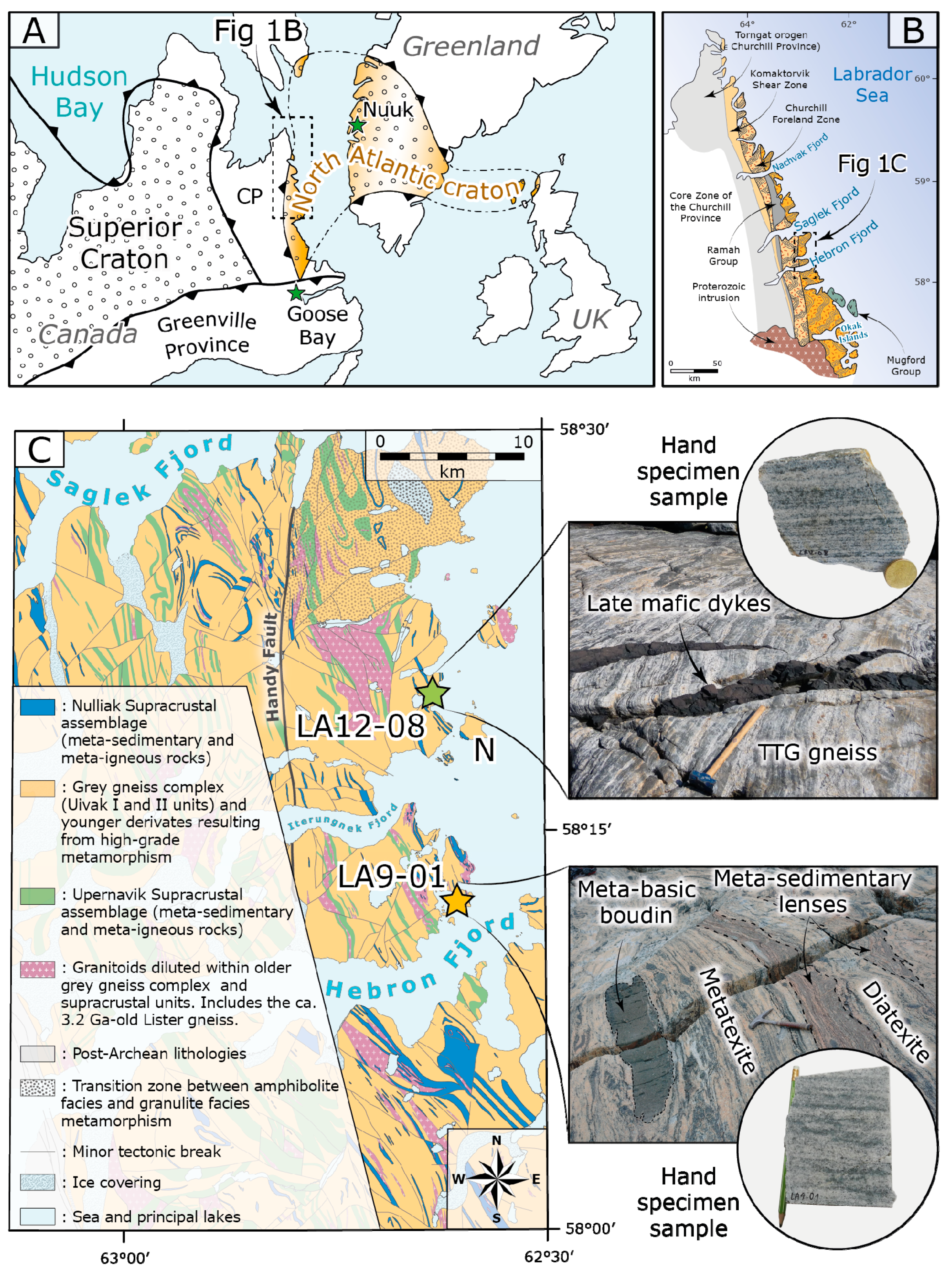
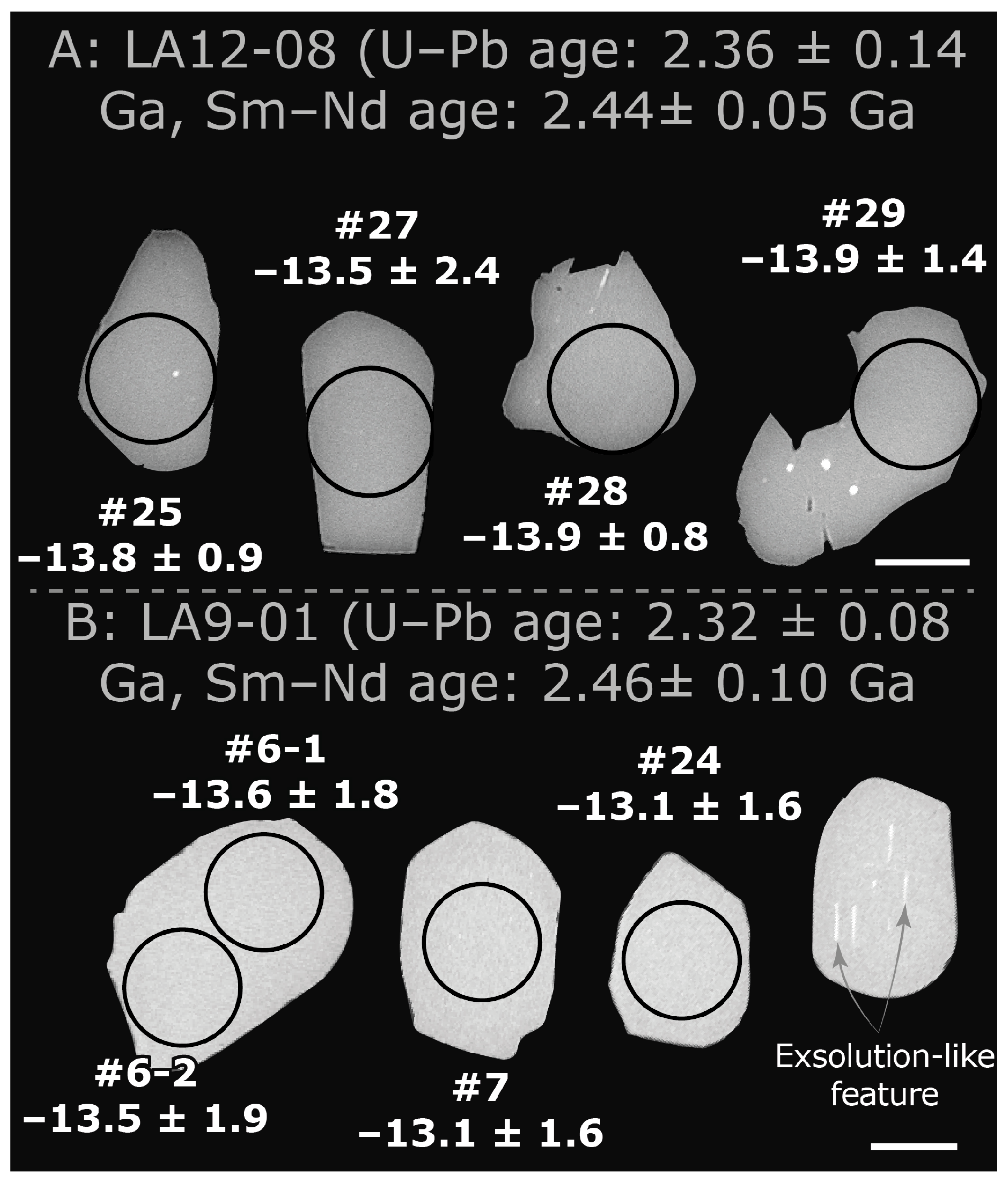
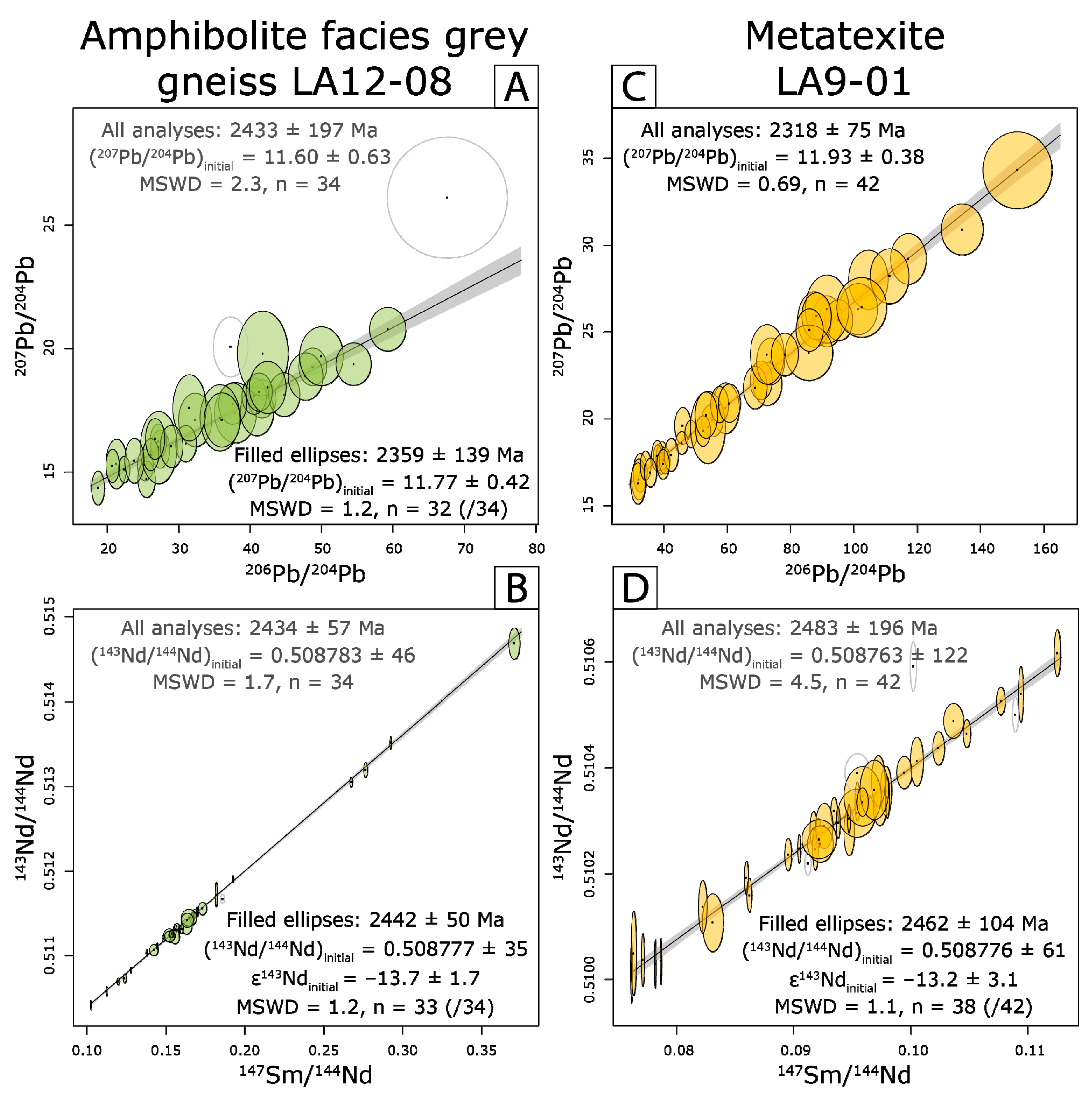

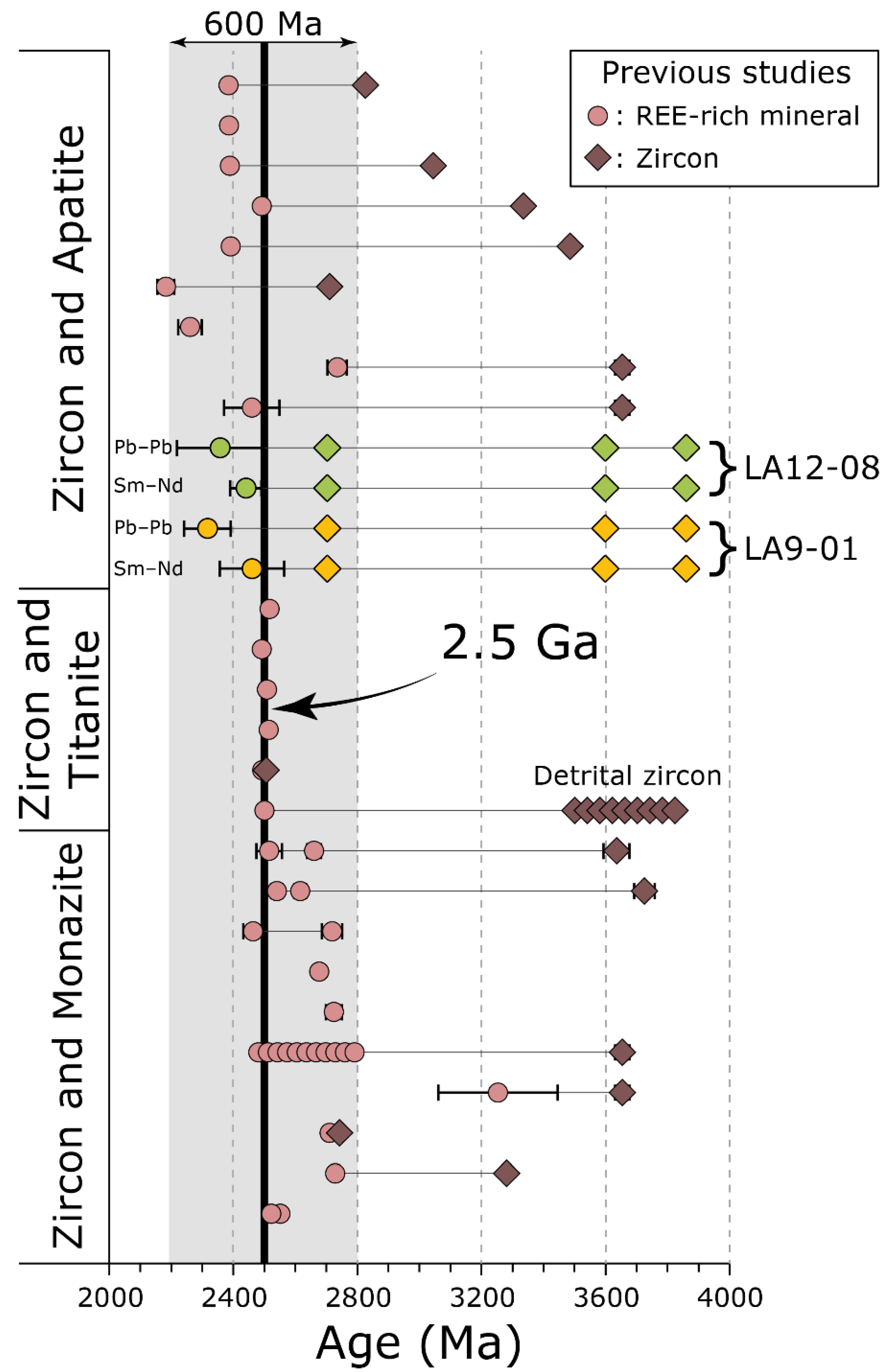
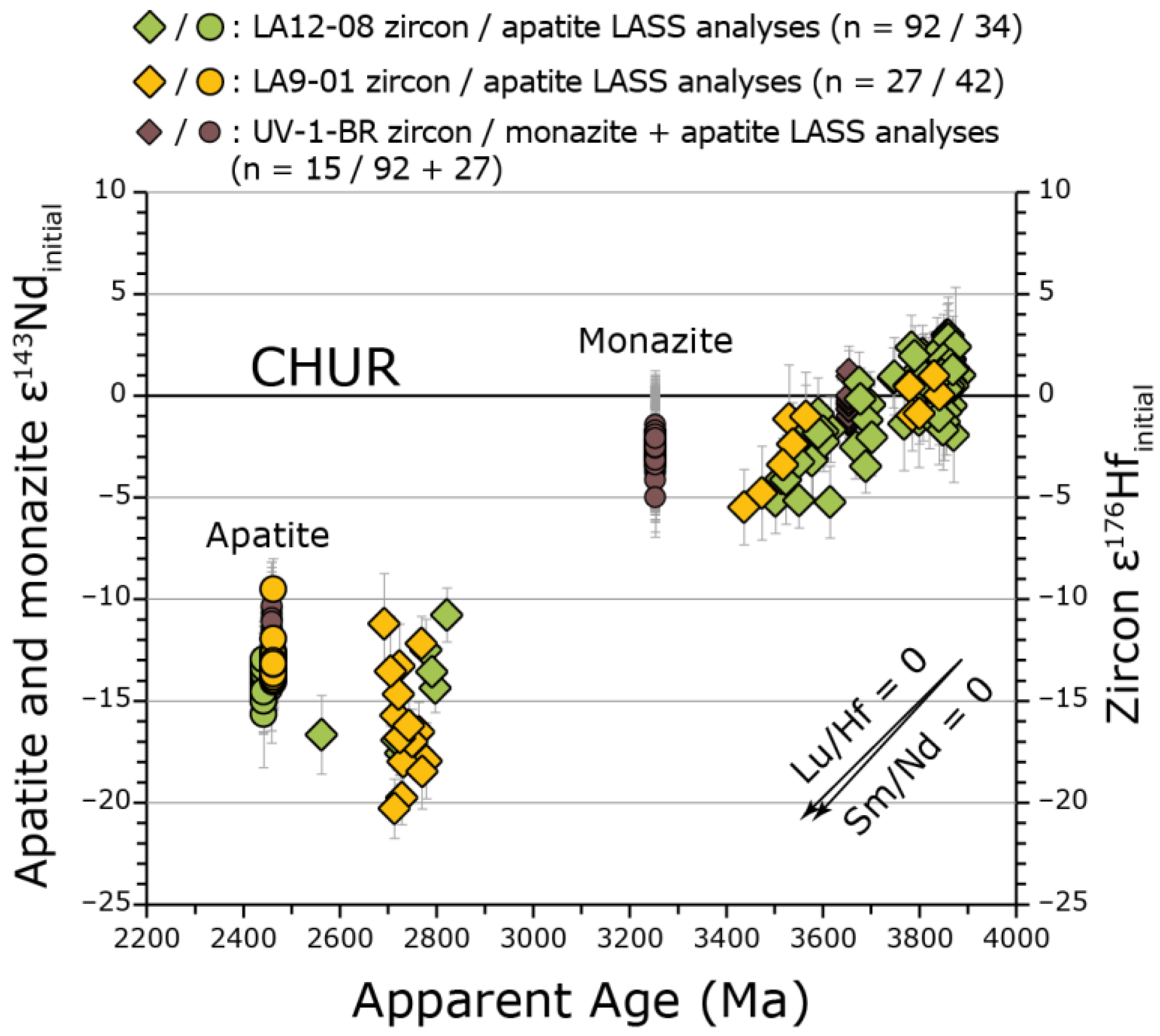

| Th | U | Pb | Sm | Nd | Pb–Pb Age ± Uncertainty (Ma) | MSWD | n | Sm–Nd Age ± Uncertainty (Ma) | MSWD | n | ε143Ndinitial | |
|---|---|---|---|---|---|---|---|---|---|---|---|---|
| Amph. facies grey gneiss LA12-08 | 0.3 | 2.6 | 3.7 | 244 | 800 | 2359 ± 139 | 1.2 | 32 (/34) | 2442 ± 50 | 1.2 | 33 (/34) | −13.7 ± 1.7 |
| Metatexite LA9-01 | 14.6 | 7.1 | 5.6 | 175 | 1075 | 2318 ± 75 | 0.69 | 42 (/42) | 2462 ± 104 | 1.1 | 38 (/42) | −13.2 ± 3.1 |
| Geological Event and Age | Emplacement- ca. 3.86 Ga | M1 Metamorphism -ca. 3.6 Ga | M2 Metamorphism -ca. 2.75–2.7 Ga | M3 Metamorphism -ca. 2.5–2.4 Ga | ||
|---|---|---|---|---|---|---|
| Amph. facies grey gneiss LA12-08 | Zircon | ε176Hfinitial | +1.6 ± 1.8 | −2.2 ± 0.6 | −17 → −10 | ? |
| δ18OVSMOW | 5.4‰ → 6.6‰ | +6.3‰ | +6.5‰ | ? | ||
| Apatite | ε143Ndinitial | ? | ? | ? | −13.7 ± 1.7 | |
| Whole-Rock | ε143Ndpresent | −45 ± 0.5 (n = 3, MSWD = 206) 1 | ||||
| Metatexite LA9-01 | Zircon | ε176Hfinitial | −0.3 ± 0.8 | −1.1 ± 0.7 | −20 → −11 | ? |
| δ18OVSMOW | 5.4‰ → 6.6‰ | up to +9‰ | +6.8‰ | ? | ||
| Apatite | ε143Ndinitial | ? | ? | ? | −13.2 ± 3.1 | |
| Whole-Rock | ε143Ndpresent | −52 ± 1.5 (n = 3, MSWD = 13) 1 | ||||
| Sample ID | Mineral Analyzed | Method | Age Calculation | Date (Ma) ± Uncertainty (95%) | Zircon Age (Ma) | Reference |
|---|---|---|---|---|---|---|
| 74−161 A | Apatite | Dissolution | 207Pb/206Pb | 2384 | 2825 | [43] |
| 74−161 B | Apatite | Dissolution | 207Pb/206Pb | 2385 | Ø | [43] |
| 74−161 C | Apatite | Dissolution | 207Pb/206Pb | 2388 | 3044 | [43] |
| 74–40 A | Apatite | Dissolution | 207Pb/206Pb | 2491 | 3334 | [43] |
| 74−161 F | Apatite | Dissolution | 207Pb/206Pb | 2391 | 3485 | [43] |
| L1429 | Apatite | LA-ICP-MS | 207Pb/206Pb | 2182 ± 27 | 2710 ± 14 | [39] |
| L1439 | Apatite | LA-ICP-MS | 207Pb/206Pb | 2260 ± 38 | Ø | [39] |
| UV-1-BR | Apatite | LASS | U.I. | 2734 ± 31 | 3654 ± 23 | [28] |
| Sm–Nd isochron | 2459 ± 89 * | |||||
| LA12-08 | Apatite | LASS | Pb–Pb isochron | 2359 ± 139 | 3860 ± 10 | This study |
| Sm–Nd isochron | 2442 ± 50 | |||||
| LA9-01 | Apatite | LASS | Pb–Pb isochron | 2318 ± 75 | 3860 ± 10 A | This study |
| Sm–Nd isochron | 2462 ± 104 | |||||
| 75–285 C | Titanite | Dissolution | 207Pb/206Pb | 2516 | Ø | [43] |
| 75–271 E | Titanite | Dissolution | 207Pb/206Pb | 2491 | Ø | [43] |
| 75–271 D | Titanite | Dissolution | 207Pb/206Pb | 2508 | Ø | [43] |
| 74−161 D | Titanite | Dissolution | 207Pb/206Pb | 2514 | Ø | [43] |
| 75–262 | Titanite | Dissolution | 207Pb/206Pb | 2492 | ca. 2505 | [43] |
| LA13−19 | Titanite | LASS | T–W Intercept | 2529 ± 15 | ≥ 3500 | [30] |
| L1419 | Monazite | EPMA | Deconvoluted | 2660 ± 22 and 2515 ± 41 | 3635 ± 42 | [39] |
| L1415 | Monazite | EPMA | Deconvoluted | 2615 ± 19 and 2540 ± 18 | 3725 ± 33 | [39] |
| L1439 | Monazite | EPMA | Deconvoluted | 2718 ± 33 and 2463 ± 31 | Ø | [39] |
| L1450 | Monazite | EPMA | Mean | 2676 ± 15 | Ø | [39] |
| L1487 | Monazite | EPMA | Mean | 2724 ± 26 | Ø | [39] |
| UV-1-BR | Monazite | LASS | Range | ca. 2790 to 2480 | 3654 ± 23 | [28] |
| Sm–Nd isochron | 3253 ± 192 *,B | |||||
| L1487 | Monazite | SIMS | Mean | 2709 ± 14 | 2742 ± 8 | [40] |
| L1492 | Monazite | SIMS | Mean | 2727 ± 6 | ca. 3280 (max) | [40] |
| L1458 | Monazite | SIMS | Mean | 2551 ± 6 and 2522 ± 8 | Ø | [40] |
Publisher’s Note: MDPI stays neutral with regard to jurisdictional claims in published maps and institutional affiliations. |
© 2022 by the authors. Licensee MDPI, Basel, Switzerland. This article is an open access article distributed under the terms and conditions of the Creative Commons Attribution (CC BY) license (https://creativecommons.org/licenses/by/4.0/).
Share and Cite
Vezinet, A.; Thomassot, E.; Luo, Y.; Sarkar, C.; Pearson, D.G. Diachronous Redistribution of Hf and Nd Isotopes at the Crystal Scale—Consequences for the Isotopic Evolution of a Poly-Metamorphic Crustal Terrane. Geosciences 2022, 12, 36. https://doi.org/10.3390/geosciences12010036
Vezinet A, Thomassot E, Luo Y, Sarkar C, Pearson DG. Diachronous Redistribution of Hf and Nd Isotopes at the Crystal Scale—Consequences for the Isotopic Evolution of a Poly-Metamorphic Crustal Terrane. Geosciences. 2022; 12(1):36. https://doi.org/10.3390/geosciences12010036
Chicago/Turabian StyleVezinet, Adrien, Emilie Thomassot, Yan Luo, Chiranjeeb Sarkar, and D. Graham Pearson. 2022. "Diachronous Redistribution of Hf and Nd Isotopes at the Crystal Scale—Consequences for the Isotopic Evolution of a Poly-Metamorphic Crustal Terrane" Geosciences 12, no. 1: 36. https://doi.org/10.3390/geosciences12010036
APA StyleVezinet, A., Thomassot, E., Luo, Y., Sarkar, C., & Pearson, D. G. (2022). Diachronous Redistribution of Hf and Nd Isotopes at the Crystal Scale—Consequences for the Isotopic Evolution of a Poly-Metamorphic Crustal Terrane. Geosciences, 12(1), 36. https://doi.org/10.3390/geosciences12010036





